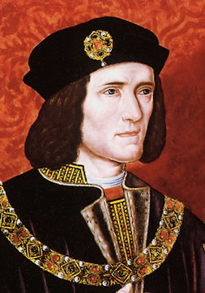 By now, you’ve seen the headlines. The bones that scientists found buried under a car park in Leicester, England, have been identified as those of the last Plantagenet king of England: Richard III. For those of you who might be new to this story, archaeologists identified and excavated the most likely burial spot for Richard III, under a car park near the Leicester City Council building, and unearthed a human skeleton with skeletal abnormalities similar to those of Richard III. Geneticists were called in to perform DNA analysis to determine if these bones were those of the English king. The DNA findings were just recently released. Now that scientists can say beyond a reasonable doubt that these bones belong to Richard III, we are learning new things about the ancient king. Continue reading “King Richard III Identified”
By now, you’ve seen the headlines. The bones that scientists found buried under a car park in Leicester, England, have been identified as those of the last Plantagenet king of England: Richard III. For those of you who might be new to this story, archaeologists identified and excavated the most likely burial spot for Richard III, under a car park near the Leicester City Council building, and unearthed a human skeleton with skeletal abnormalities similar to those of Richard III. Geneticists were called in to perform DNA analysis to determine if these bones were those of the English king. The DNA findings were just recently released. Now that scientists can say beyond a reasonable doubt that these bones belong to Richard III, we are learning new things about the ancient king. Continue reading “King Richard III Identified”
Richard III
Are These the Bones of Richard III?
In central England, an archaeological dig is happening in an unlikely spot—a parking lot in the city of Leicester. The goal: To find the final resting spot of Richard III, the last of England’s Plantagenet kings and perhaps one of its most maligned rulers. Richard III reigned over England for only two years before being killed by Henry Tudor’s army during the Battle of Bosworth Field in August 1485 at the end of the War of the Roses, which pitted Richard’s House of York against the House of Lancaster. Many historical records suggest that Richard’s body was brought to Leicester and buried between the nave and altar at Grey Friars church. You would think that a king’s tomb would be well marked and well remembered, even for an unpopular king like Richard III, but that is not the case here. Henry was said to have erected a memorial for his former rival, but that and any other monuments, along with the church itself, are long gone, destroyed during the Dissolution of the Monasteries, when Henry VIII was named Supreme Head of the Church in England and systematically razed monasteries, convents and friaries throughout England, Wales and Ireland between 1536 and 1541. Since then, the exact location of Richard III’s remains was lost to history. However, thanks to a team of University of Leicester archaeologists and geneticists that might be changing.
